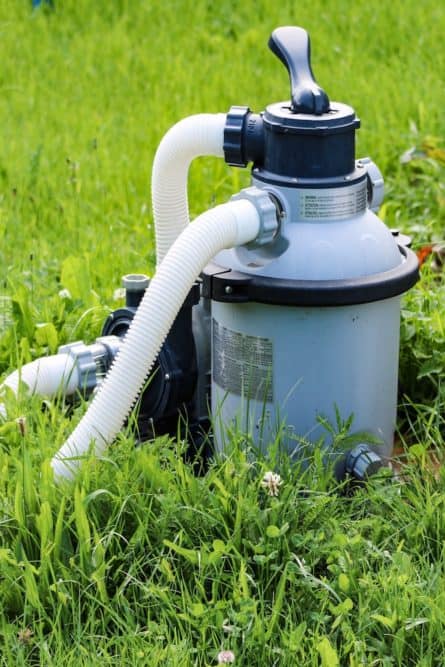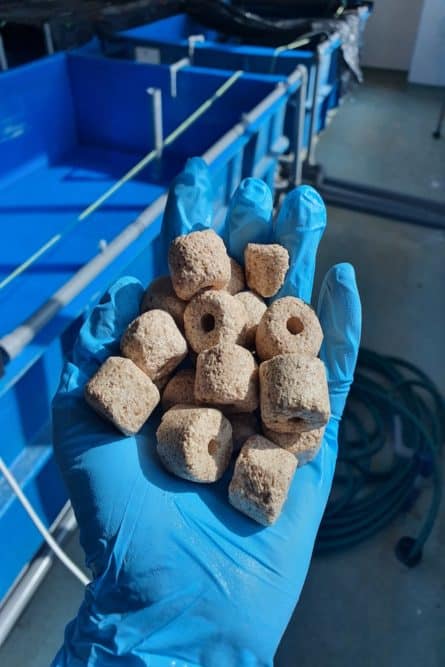Many koi fish owners use filter pads to keep their ponds looking clean, but the reality is that most algae aren’t toxic. Instead, the right filtration system will remove harmful, invisible toxins from your water in addition to keeping it debris-free.
I’ve gone through my fair share of trial and error to keep my koi fish healthy and my family happy with having a clean pond in our backyard. So, I’ll share what I’ve learned with you here.
Two primary filtration systems use koi pond filter pads. I’ll introduce you to these systems, tell you why you should use both of them, and help you understand the general mechanics of how filter pads function.
A koi pond filter pad works in conjunction with a filter to trap particles to help keep the water clean. And I’m not only talking about keeping the water debris-free-filter pads help reduce the chances of deadly toxins like ammonia and nitrite from building up in your fish pond.
As is appropriate for a koi’s size, koi pond filter pads come in large bundles, almost looking like a rolled-up sleeping bag.
That large size is crucial, and it’s something that I’ll be talking about shortly. The bottom line is you can’t use a filter pad for your 20-gallon indoor aquarium and expect it to keep your pond clean.
When you’re trying to understand how koi pond filter pads work, it’s essential to know that you have one of two pond filtration systems to choose from-biological filtration and mechanical filtration.
Let’s explore the mechanics of each.
Biological filtration is a favorite among environmentalists, as it uses beneficial bacteria to help break down ammonia. It also encourages this bacterium to reproduce so it can more effectively break down harmful particles.
The bacteria first break down ammonia into nitrites. However, nitrites are dangerous to koi fish, so it doesn’t end there. They then turn the nitrites into nitrates, which aren’t as harmful. If this sounds familiar from your high school chemistry days, it’s the nitrogen cycle at work.
As these good bacteria go through the nitrogen cycle, they push bad waste through the biological filter pad. As a result, it’s crucial to check your filter media regularly to ensure clogging isn’t happening. If that’s the case, then what remains of the nitrate and bed chemicals could end up going back into your pond.
Mechanical filtration is easier for non-chemists to understand. It uses a filter mat to remove visible waste physically. Therefore, it helps to keep your pond water looking like much desired crystal clear water.
But there’s a catch-mechanical filtration doesn’t remove non-visible waste like ammonia and nitrite. Therefore, it’s a common mistake for koi fish owners to see their clean pond and believe that they’re doing an excellent job of maintaining it.
In reality, their fish could be suffering from toxins in the water that can lead to deadly diseases like ammonia poisoning.
From choosing the size of your koi pond to the vegetation your fish will love the most, many choices go into building a safe pond to keep your koi happy. And those choices continue when it comes to selecting your filter system.
Using a koi pond filter media for biological and mechanical filters is the best way to keep your pond physically and visually clean. However, within these two filters, you have several systems that you can choose from.
Bead filters are a mechanical type of filter that functions like a filter you’d use on a pool. It has a bucket that collects debris, allowing you to check and toss out the trash regularly. As its name implies, it contains beads, and this increases its surface area. As a result, beneficial bacteria often grow on this filter, creating a small biological filter at the same time.
A pressurized pond filter is a lot like it sounds-it sucks in water from your pond and then releases it at high pressure. The result is a fast and efficient cleaning of your pond water. It’ll even trap dirt and remove the green hue from your pond if it has one.

When it comes to biological filters, it’s the filter media that makes the difference. You should aim to choose your filter media according to the size of your koi pond; the larger the pond, the more surface area your biological filter will need so that nitrifying bacteria has room to grow.
Examples of biological filter media include:

First things first-to avoid wearing down your koi pond filter pads too quickly, I recommend doubling the filter pad according to the gallons of water in your pond. So, if you have an 800-gallon koi pond, you should install filters that can handle 1,600 gallons of water.
When in doubt, the larger the filter you install, the better, as too much filtering won’t harm your fish.
Mechanical filters require more maintenance than biological filters because you’ll need to physically remove the debris weekly. The method you use to clean out your mechanical filter will vary depending on its style, but it may involve removing the filter pad and cleaning it with a hose.
In contrast, biological filter pads only need annual cleaning. To do so, take the filter and move it through your pond to clean out any gunk and debris. The idea is to keep the beneficial bacteria in the water, which is why you should perform this process in your pond.
Furthermore, you should never use chlorinated water during the cleaning process because it’ll kill the bacteria.
Finally, if you have a smaller tank and prefer to have just one filter for lower maintenance, choose a biological filter over a mechanical one. Your pond may become an eyesore because of it, but your koi fish will enjoy the healthy balance of chemicals in their water.
You're going to periodically need to replace your existing filter pads. Fortunately, we've created an online directory of koi pond suppliers that you can use to find filter pads at a store near you - or you can order filter pads online.



